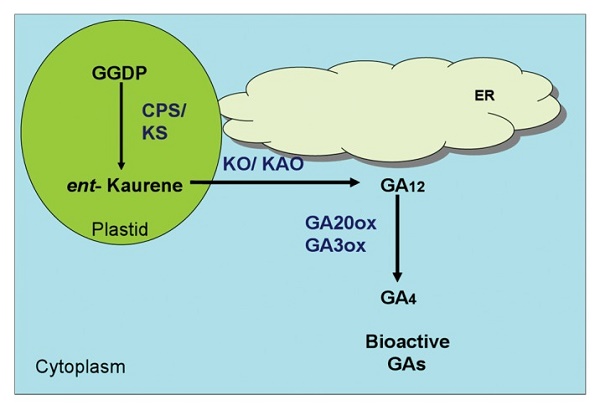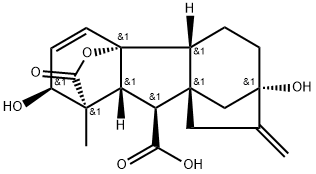Chemical Properties
white powder
Uses
Gibberellic Acid is a a pentacyclic diterpene acid. Gibberellic Acid is a hormone that is found in plants which promotes the growth and elongation of cells. Gibberellic acid acts as a plant growth reg
ulator on account of its physiological and morphological effects in extremely low concentrations. Generally Gibberellic acid affects only the plant parts above the soil surface.
Definition
ChEBI: A C19-gibberellin that is a pentacyclic diterpenoid responsible for promoting growth and elongation of cells in plants.
General Description
White powder.
Air & Water Reactions
Slightly water soluble .
Reactivity Profile
Gibberellic acid is readily degraded by acids. .
Fire Hazard
Flash point data for Gibberellic acid are not available. Gibberellic acid is probably combustible.
Biosynthesis
The presence of GA in actively growing tissues, i.e., shoot apices, young leaves, and flowers. Gibberellins (GAs; Gibberellic acids) being synthesized via the terpenoid pathway, require 3 enzymes viz., terpene synthase (TPSs), cytochrome P450 monooxygenase (P450s) and 2-oxoglutarate dependent dehydrogenase (2 ODDs), for the biosynthesis of bioactive GA from geranylgeranyl diphosphate in plants. Two terpene synthases, ent-copalyl diphosphate synthase (CPS) and ent-kaurene synthase (KS), located in plastids, are involved in the conversion of GGDP to tetracyclic hydrocarbon intermediate ent-kaurene. ent-Kaurene is then converted to GA12 by 2 P450s. First, ent-Kaurene oxidase (KO), present in the plastid's outer membrane, catalyzes the sequential oxidation of C-19 to produce ent-kaurenoic acid. Second, the kaurenoic acid oxidase (KAO) in the endoplasmic reticulum is converted to GA12. Bioactive GA4 is converted from GA12 through oxidations on C-20 and C-3 by GA 20-oxidase (GA20ox) and GA 3-oxidase (GA3ox)[3].

Agricultural Uses
Gibberellic acid is an organic acid used as a plant growth hormone. It is formed by the fungus Gibberellafujikuroi in aerated submerged culture.
Agricultural Uses
Gibberellin is a growth promoting substance found widely in plants. It was first isolated from the fungus Gibberella. Gibberellin increases the rate of photosynthesis and helps in the elongation of cells. It promotes the flowering and germination of plants. With a general formula of Cl9H22O6, gibberellins are also produced by Azotobacter, Azospirillum, etc.
Agricultural Uses
Plant growth hormone, Plant regulator: Gibberellic acids (Gibberellins) are naturally occurring plant hormones that are used as plant growth
regulators to stimulate both cell division and elongation
that affects leaves and stems. Applications of this hormone also hastens plant maturation and seed germination.
Delayed harvesting of fruits, allowing them to grow larger.
Gibberellic acids are applied to growing field crops, small
fruits, grapes, vines and tree fruit, and ornamentals, shrubs
and vines.
Trade name
ACTIVOL®; BERELEX®; BRELLIN®;
BOLL-SET®; CEKUGIB®; CROP BOOSTER®;
CYTOPLEX HMS®, DYNOGEN®; FALGRO®;
FLORALTONE® (with 2,3,5-triiodobenzoic acid);
FLORGIB®; FOLI-ZYME®; GIBBEX®; GIBBERELLIN
A 3 ®; GIBBERELLIN X®; GIBBREL®; GIBGRO®;
GIB-SOL®; GIB-TABS®; GIBRESCOL®; GROCEL®;
KALGIBB®; MAXON®; N-LARGE®; NOVAGIB®;
PGR-IV®; PRO-GIBB®; REGULEX®; RELEASE®;
RELAX®; RYZUP®; STIMULATE®; VIGOR®
Biochem/physiol Actions
Phytohormone that controls important aspects of plant growth: germination, elongation, and flowering. The effects are mediated by inducing degradation of the DELLA repressor protein, and probably other minor signalling pathways.
Purification Methods
It crystallises from EtOAc, EtOAc/pet ether, MeOH/pet ether or Me2CO/pet ether. [Cross J Chem Soc 3022 1960, Beilstein 18 III/IV 6533.]
Toxicity evaluation
75 ppm of Gibberellic acid (GA3) in drinking water was continuously administered orally to rats (Sprague-Dawley albino) ad libitum for 50 days. The lipid peroxidation end product MDA significantly increased in the lungs, heart, and kidney of rats treated with GA3 without significant change in the spleen. Antioxidant enzyme activities such as SOD significantly increased in the lungs and stomach and decreased in the spleen and heart tissues of rats treated with GA3[4].

